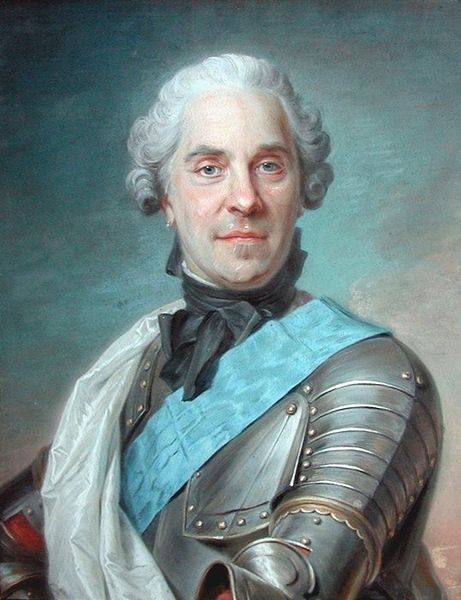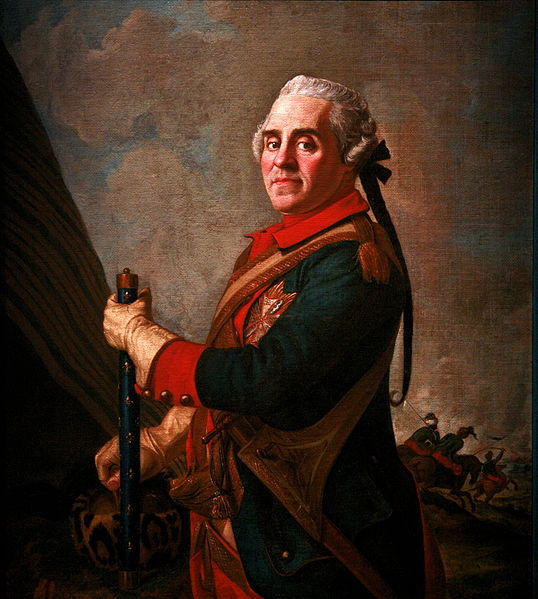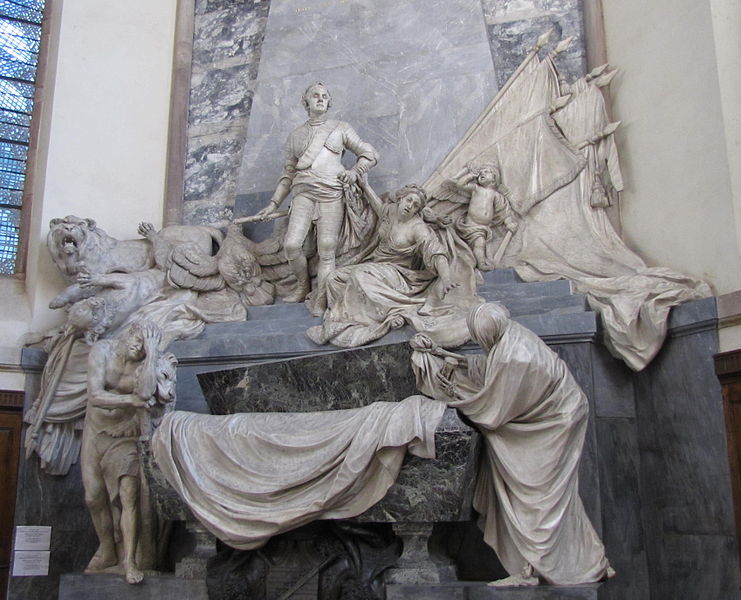<Back to Index>
- Maréchal Général des Camps et Armées du Roi Maurice de Saxe, 1696
PAGE SPONSOR


Maurice de Saxe (German: Moritz Graf von Sachsen) (28 October 1696 – 20 November 1750) was a German in French service who was Marshal and later also Marshal General of France.
Maurice was born at Goslar, an illegitimate son of August the Strong, King of Poland and Elector of Saxony, and the Countess Maria Aurora of Königsmarck. He was the first of eight extramarital children whom August acknowledged, although as many as 354 are claimed by sources, including Wilhelmine of Bayreuth, to have existed.
In 1698, the Countess sent him to his father in Warsaw. August had been elected King of Poland in
the previous year, but the unsettled condition of the country obliged
Maurice to spend the greater part of his youth outside its borders. This
separation from his father made him independent and had an important
effect on his future career.
At the age of twelve, Maurice served in the army of Prince Eugene of Savoy, at the sieges of Tournai and Mons and at the Battle of Malplaquet. A proposal at the end of the campaign to send him to a Jesuit college in Brussels was dropped due to the protests of his mother. When only thirteen years of age Maurice apparently had a brief liaison with a girl called Rosette Dubosan, daughter of a lace maker in Tournai. The product of the affair, a girl, was born 27 June 1710 in Brussels and died there in February 1711, aged 8 months.
Upon his return to the camp of the Allies at the beginning of 1710, Maurice displayed a courage so impetuous that Prince Eugene admonished him to not confuse rashness with valour.
He next served under Peter the Great against the Swedes. In 1711, August formally recognized him and Maurice was granted the rank of Count. He then accompanied his father to Pomerania, and in 1712 he took part in the siege of Stralsund. At the age of 17 in 1713 he commanded his own regiment.
In manhood, Maurice bore a strong resemblance to his father, both physically and in character. His grasp was so powerful that he could bend a horseshoe with his hand, and even at the end of his life, his energy and endurance were scarcely affected by the illnesses his many excesses had caused.
On 12 March 1714, a marriage was arranged between him and one of the richest of his father's subjects, Countess Johanna Viktoria Tugendreich von Loeben, but he dissipated her fortune so rapidly that he was soon heavily in debt. The next year (21 January 1715), Johanna gave birth to a son, called August Adolf after his grandfather; the child only lived a few hours. Since Maurice had also given her more serious grounds of complaint against him, he consented to an annulment of the marriage in 21 March 1721.
After serving in a campaign against the Ottoman Empire in 1717, he went to Paris to study mathematics, and in 1720 obtained a commission as maréchal de camp. In 1725, he entered negotiations for election as Duke of Courland, at the insistence of the Duchess Anna Ivanovna, who offered him her hand. He was chosen Duke in 1726, but declined marriage with the duchess. He soon found it impossible to resist her opposition to his claims, but with the assistance of £30,000 lent him by the French actress Adrienne Lecouvreur, he raised a force by which he maintained his authority till 1727, when he withdrew and took up residence in Paris.
At the outbreak of the War of the Polish Succession, Saxe served under Marshal the Duke of Berwick, and for a brilliant exploit at the Siege of Philippsburg he was named lieutenant - general. In the War of the Austrian Succession he took command of an army division sent to invade Austria in 1741, and on 19 November 1741, surprised Prague during the night, and seized it before the garrison was aware of the presence of an enemy, a coup de main which made him famous throughout Europe; he thus repeated the exploit of 1648 of his maternal great - grandfather, Hans Christoff von Königsmarck. After capturing the fortress of Eger (Cheb) on
19 April 1742, he received a leave of absence, and went to Russia to
push his claims for the Duchy of Courland, but returned to his command
after getting nowhere.
Saxe's exploits were the sole redeeming feature in an unsuccessful campaign, and on 26 March 1743, his merits were rewarded by promotion to Marshal of France. He had been given only 50 - 60,000 men to defend against an enemy army twice as large. From this time on, he became one of the great generals of the age. In 1744, he was chosen to command the 10,000 men of the French Invasion of Britain on behalf of the Old Pretender, which assembled at Dunkirk but did not proceed more than a few miles out of harbor before being wrecked by disastrous storms. After its termination, he received an independent command in the Netherlands, and by skilful maneuvering succeeded in continually harassing the superior forces of the enemy without risking a decisive battle.
In the following year, Saxe with 65,000 men besieged Tournai and inflicted a severe defeat on the army of the Duke of Cumberland at the Battle of Fontenoy, an encounter determined entirely by his constancy and cool leadership. During the battle, he was unable to sit on horseback due to edema, and was carried about in a wicker chariot.
In recognition of his brilliant achievement, King Louis XV of France conferred on him the Château de Chambord for life, and in April 1746, he was naturalized as a French subject. Until the end of the war, he continued to command in the Netherlands, always with success. He was given command of 200,000 men in 1746. Besides Fontenoy he added Rocoux (1746) and Lawfeldt or Val (1747) to the list of French victories. He led the French force which captured Brussels and it was under his orders that Marshal Löwendahl captured Bergen op Zoom. He himself won the last success of the war in capturing Maastricht in 1748. In 1747 the title once held by Turenne and Villars, "Marshal General of the King's camps and armies", was revived for him. But on 20 November 1750 he died at the Château de Chambord "of a putrid fever".
During the last years of his life, Maurice had an affair with a French lady, Marie Rinteau de Verrières, who at that time was only eighteen years old. In 1748 she gave birth to a daughter, the last of Maurice's several illegitimate children. She was called Maria Aurora (in French: Marie Aurore) after her grandmother. During the first year of her life, she bore the surname de la Riviere, until her father, shortly before his own death, recognized her as his daughter and gave her the surname von Sachsen or de Saxe. By her second marriage with Claude Dupin de Franceuil, Marie Aurore married in 1764 Antoine, comte d'Horne (1735 – 1765), an illegitimate son of Louis XV of France by an unknown mother. By second marriage she was the grandmother of Amandine Lucile Aurore Dupin, who later became famous as the writer George Sand, and died on 25 December 1821.
Saxe wrote a remarkable work on the art of war, Mes Rêveries, which though described by Carlyle as "a strange military farrago, dictated, as I should think, under opium", is in fact a classic. Published posthumously in 1757, it was described by Lord Montgomery, more than two centuries later, as in fact "a remarkable work on the art of war." Saxe's Lettres et mémoires choisis appeared in 1794. His letters to his sister, the Princess of Holstein, preserved at Strasbourg, were destroyed by the bombardment of that place in 1870. Thirty copies had, however, been printed from the original.
Many previous errors in former biographies were corrected and additional information supplied in Carl von Weber's Moritz Graf von Sachsen, Marschall von Frankreich, nach archivalischen Quellen [Moritz Count of Saxony, Marshal of France, after archival sources] (Leipzig, 1863), in Saint - René Taillandier's Maurice de Saxe, étude historique d'après les documents des archives de Dresde [Maurice de Saxe, historical study according to the documents from the archives of Dresden] (1865) and in C.F. Vitzthum's Maurice de Saxe (Leipzig, 1861).
A biography in English is Jon Manchip White's Marshal of France: The Life and Times of Maurice, Comte de Saxe [1696 - 1750] (Rand McNally & Company, Chicago, 1962). See also the military histories of the period, especially Carlyle's Frederick the Great.
